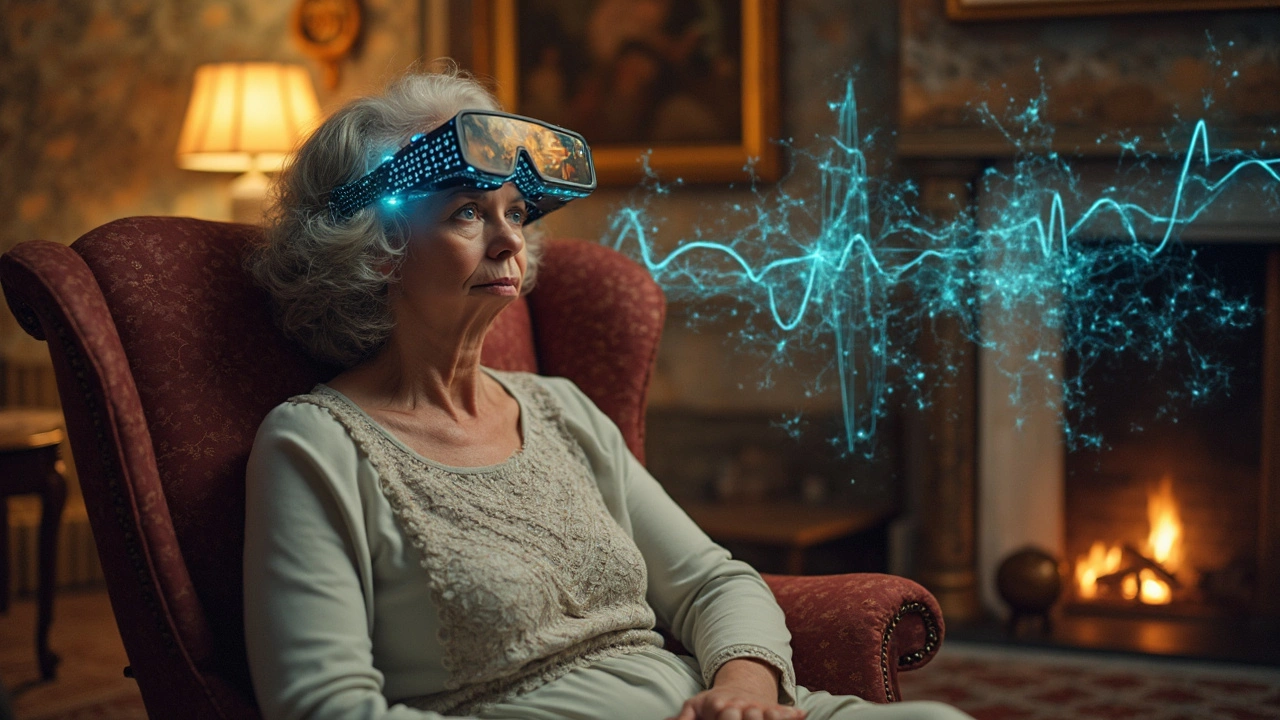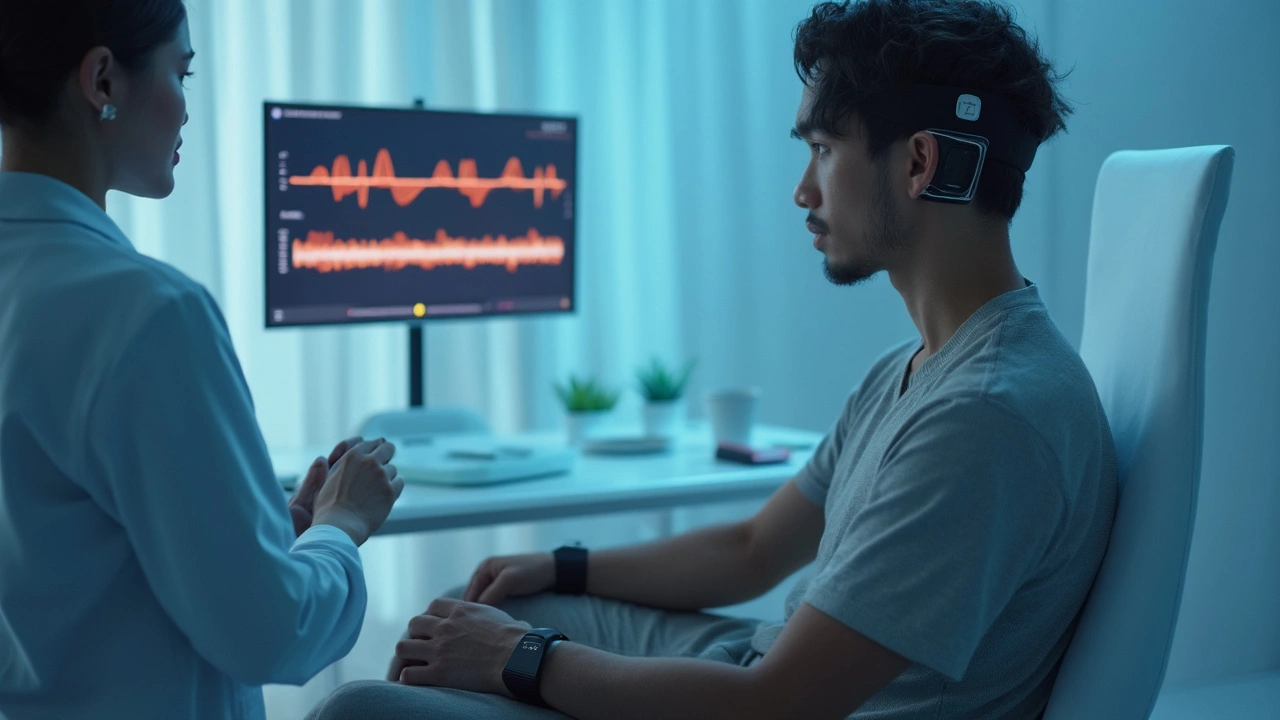Ever wondered how you could gain control over your body's functions without breaking into a sweat at the gym? Biofeedback offers just that! By providing real-time data about what's going on inside, like your heart rate or muscle tension, it's giving people more control over their health than ever before.
Let me break it down for you: biofeedback uses sensors attached to your body to measure certain functions, and then it gives feedback so you can learn to regulate them. It's like having a personal coach who whispers tips in your ear before things go haywire. This smart tech is particularly handy for people dealing with stress or anyone looking to manage chronic pain without popping pills every few hours.
If you’re all about the numbers, here's a fun fact for you: using biofeedback can lead to a 50% reduction in stress-related symptoms, according to a study from 2022. Now, who wouldn’t want that?
- Understanding Biofeedback
- Applications in Stress Reduction
- Managing Chronic Conditions
- Future of Biofeedback
Understanding Biofeedback
The term biofeedback might sound like something straight out of a sci-fi movie, but it’s a real, tangible, and incredibly useful healthcare technique. At its core, biofeedback is all about turning the subtle whispers of your body into actionable data. Through the use of sensors, it tracks bodily functions like brainwaves, heart rate, breathing, muscle activity, and even skin temperature.
So, how does this all work in practice? Imagine you've got this biofeedback device that's like your body’s personal translator. It picks up on those internal cues and then translates them into visual or auditory feedback. For instance, you may see graphs on a screen demonstrating your heart rate variability or hear a tone indicating your stress level. This feedback is crucial because it teaches you how to make the necessary tweaks to bring these functions back into balance. By learning these adjustments, individuals can potentially reduce stress, enhance mental clarity, and improve their overall well-being.
How Biofeedback is Used
Biofeedback is hands down a game-changer in many areas, from clinical settings to home use. It's mainly used for conditions that stress, tension, or pain exacerbate. For instance, people with hypertension might employ biofeedback to learn relaxation techniques that lower blood pressure.
- Muscle Tension: People often use it for physical therapy, especially to retrain muscles after an injury.
- Stress Management: Tracking stress responses can help develop strategies to stay calm under pressure.
- Chronic Pain Management: Conditions like migraines and fibromyalgia can benefit as biofeedback can teach ways to reduce pain episodes.
The technology isn’t just stuck in doctor's offices anymore; many devices and apps are portable, allowing you to practice biofeedback exercises right from your living room sofa. This means biofeedback's impact is growing, offering benefits beyond just therapy sessions.
If you've got a smartphone, you've likely already got some form of biofeedback at your fingertips. Apps often utilize the basic concept of biofeedback to guide breathing exercises, meditation, or even help with yoga practices by tracking and interpreting your body's responses.
Applications in Stress Reduction
Stress is like that annoying friend who just doesn't know when to leave. But what if you could send it packing with a little help from biofeedback? This tech is making waves in stress management for more reasons than one.
Let's start with the basics. Biofeedback can help you become more aware of physiological signs of stress, like increased heart rate or sweaty palms. By using this information, you can learn techniques to calm yourself down.
Real-Life Applications
One of the big wins for biofeedback is in stress management. When you’re stressed, your body gives off signals, like your heartbeat turning into a drum solo. Using biofeedback, you can learn how these signals affect you and how to react to them.
Practically speaking, biofeedback devices—many of which are now available in wearable formats—can guide you through breathing exercises or mindfulness sessions. Over time, this helps reduce anxiety levels and improve overall mental health.
Stress-Reducing Techniques
- Deep Breathing Exercises: Using data from a biofeedback device, you can practice slow, deep breaths to bring down your heart rate.
- Progressive Muscle Relaxation: Through biofeedback, you can learn which muscles are tense and work on relaxing them one by one.
- Mindfulness Meditation: Stay in the moment with help from biofeedback, which keeps track of your stress indicators, letting you know if your mind starts to wander.
These techniques are not just fluff—imagine lowering your anxiety without needing to see a therapist every week. And while we're at it, a tablet is more than a screen for Netflix; many apps now offer biofeedback features that connect to wearables, making it accessible for everyday use.
| Technique | Typical Stress Reduction |
|---|---|
| Deep Breathing | 30-40% |
| Muscle Relaxation | 20-30% |
| Mindfulness | 30-50% |
So, in a nutshell, if you're looking to kick stress to the curb, biofeedback might just be the tool you need. It’s all about taking back control and having a bit more peace of mind.

Managing Chronic Conditions
Living with chronic conditions like hypertension or diabetes can feel like an endless juggling act. But what if I told you that biofeedback could help you keep those balls in the air without dropping them? That's right. This technology is proving to be a game-changer in managing long-term health issues.
How Biofeedback Works for Chronic Conditions
Here's the lowdown: by using sensors to monitor physiological signals like blood pressure or muscle tension, biofeedback helps you identify and, more importantly, change your body's responses to stress or pain triggers.
For instance, someone with chronic hypertension might use biofeedback to learn how to relax blood vessels through breathing exercises. It’s not just a theory; research has shown measurable improvements!
Benefits and Techniques
Why is this worth your attention? Well, biofeedback isn’t just about data; it's about action. Patients often report reduced reliance on medication and improved overall quality of life.
- Stress Reduction: Lowering stress can alleviate symptoms for conditions like irritable bowel syndrome (IBS) and migraines.
- Pain Management: Biofeedback offers an alternative to medication by teaching you to harness your body’s natural relaxation response.
- Behavioral Changes: It can help create healthier habits by promoting awareness of the body's signals.
Getting Started with Biofeedback
If you’re intrigued, start simple. Many apps and devices can be used at home, but consulting a healthcare professional can tailor the approach to your specific needs. Remember, consistency is key to seeing significant results.
| Condition | Biofeedback Approach | Improvement Rate |
|---|---|---|
| Hypertension | Breathing exercises | 30% reduction in systolic blood pressure |
| Chronic Migraine | Muscle relaxation | 50% reduction in headache frequency |
Intrigued? Whether you're tech-savvy or a total newbie, biofeedback offers a practical, non-invasive way to tackle chronic conditions head-on. Time to take back control!
Future of Biofeedback
When it comes to healthcare, the future is often linked with innovation, and biofeedback is riding that wave like a pro surfer. As technology gets better and devices become more affordable, biofeedback is set to become a household name in health and wellness.
One exciting development is the integration of biofeedback with wearable tech. Imagine your smartwatch not only tracking your steps but also offering insights into your stress levels and giving you real-time advice on how to calm down. The convenience of having such tools handy is set to make stress management part of our daily routine.
Expanding Applications
Right now, biofeedback is mainly used for managing stress and chronic conditions, but the possibilities are endless. Researchers are looking into its potential to aid in mental health treatments, like for anxiety and depression. It could even play a role in enhancing focus and performance in athletes or students.
Innovations in the Healthcare System
We're also seeing interest from healthcare providers who are integrating biofeedback into patient care plans. Chronic conditions like hypertension or migraines can be better managed if patients understand how to control their physiological responses. This personalized care approach not only improves outcomes but also empowers patients to take charge of their health.
Here's a quick look at predicted growth:
| Year | Global Biofeedback Market Size (in $ billion) |
|---|---|
| 2025 | 1.7 |
| 2030 | 3.4 |
As you can see, the potential for growth in the biofeedback space is massive. With more research, we might soon have solutions we haven't even dreamed of yet.





